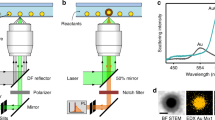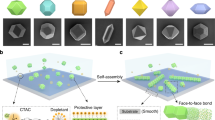Abstract
Next-generation ‘smart’ nanoparticle systems should be precisely engineered in size, shape and composition to introduce multiple functionalities, unattainable from a single material1,2,3. Bottom-up chemical methods are prized for the synthesis of crystalline nanoparticles, that is, nanocrystals, with size- and shape-dependent physical properties4,5,6, but they are less successful in achieving multifunctionality7,8,9. Top-down lithographic methods can produce multifunctional nanoparticles with precise size and shape control2,3,10,11, yet this becomes increasingly difficult at sizes of ∼10 nm. Here, we report the fabrication of multifunctional, smart nanoparticle systems by combining top-down fabrication and bottom-up self-assembly methods. Particularly, we template nanorods from a mixture of superparamagnetic Zn0.2Fe2.8O4 and plasmonic Au nanocrystals. The superparamagnetism of Zn0.2Fe2.8O4 prevents these nanorods from spontaneous magnetic-dipole-induced aggregation, while their magnetic anisotropy makes them responsive to an external field. Ligand exchange drives Au nanocrystal fusion and forms a porous network, imparting the nanorods with high mechanical strength and polarization-dependent infrared surface plasmon resonances. The combined superparamagnetic and plasmonic functions enable switching of the infrared transmission of a hybrid nanorod suspension using an external magnetic field.
This is a preview of subscription content, access via your institution
Access options
Subscribe to this journal
Receive 12 print issues and online access
$259.00 per year
only $21.58 per issue
Buy this article
- Purchase on Springer Link
- Instant access to full article PDF
Prices may be subject to local taxes which are calculated during checkout




Similar content being viewed by others
References
Kircher, M. F. et al. A brain tumor molecular imaging strategy using a new triple-modality MRI-photoacoustic-Raman nanoparticle. Nat. Med. 18, 829–834 (2012).
Perry, J. L., Herlihy, K. P., Napier, M. E. & Desimone, J. M. PRINT: a novel platform toward shape and size specific nanoparticle theranostics. Acc. Chem. Res. 44, 990–998 (2011).
Zhang, M. et al. Magnetically ultraresponsive nanoscavengers for next-generation water purification systems. Nat. Commun. 4, 1866 (2013).
Murray, C. B., Kagan, C. R. & Bawendi, M. G. Synthesis and characterization of monodisperse nanocrystals and close-packed nanocrystal assemblies. Annu. Rev. Mater. Sci. 30, 545–610 (2000).
Sun, S. et al. Monodisperse MFe2O4 (M=Fe, Co, Mn) nanoparticles. J. Am. Chem. Soc. 126, 273–279 (2004).
Huang, X., Neretina, S. & El-sayed, M. A. Gold nanorods: from synthesis and properties to biological and biomedical applications. Adv. Mater. 21, 4880–4910 (2009).
Ghosh Chaudhuri, R. & Paria, S. Core/shell nanoparticles: classes, properties, synthesis mechanisms, characterization, and applications. Chem. Rev. 112, 2373–2433 (2012).
Wang, C., Xu, C., Zeng, H. & Sun, S. Recent progress in syntheses and applications of dumbbell-like nanoparticles. Adv. Mater. 21, 3045–3052 (2009).
Rivest, J. B. & Jain, P. K. Cation exchange on the nanoscale: an emerging technique for new material synthesis, device fabrication, and chemical sensing. Chem. Soc. Rev. 42, 89–96 (2013).
Sundararajan, S., Lammert, P. E., Zudans, A. W., Crespi, V. H. & Sen, A. Catalytic motors for transport of colloidal cargo. Nano Lett. 8, 1271–1276 (2008).
Zhang, M. et al. High-density 2D homo- and hetero- plasmonic dimers with universal sub-10-nm gaps. ACS Nano 9, 9331–9339 (2015).
Yun, H. et al. Alternate current magnetic property characterization of nonstoichiometric zinc ferrite nanocrystals for inductor fabrication via a solution based process. J. Appl. Phys. 119, 113901 (2016).
Peng, S. et al. A facile synthesis of monodisperse Au nanoparticles and their catalysis of CO oxidation. Nano Res. 1, 229–234 (2008).
Fafarman, A. T. et al. Chemically tailored dielectric-to-metal transition for the design of metamaterials from nanoimprinted colloidal nanocrystals. Nano Lett. 13, 350–357 (2013).
Chen, W. et al. Large-area nanoimprinted colloidal Au nanocrystal-based nanoantennas for ultrathin polarizing plasmonic metasurfaces. Nano Lett. 15, 5254–5260 (2015).
Magagnosc, D. J. et al. Effect of ion irradiation on tensile ductility, strength and fictive temperature in metallic glass nanowires. Acta Mater. 74, 165–182 (2014).
Gauvin, M., Wan, Y., Arfaoui, I. & Pileni, M. P. Mechanical properties of Au supracrystals tuned by flexible ligand interactions. J. Phys. Chem. C 118, 5005–5012 (2014).
Wang, Y. et al. Fracture and failure of nanoparticle monolayers and multilayers. Nano Lett. 14, 826–830 (2014).
Sedlmayr, A. et al. Existence of two twinning-mediated plastic deformation modes in Au nanowhiskers. Acta Mater. 60, 3985–3993 (2012).
Espinosa, H. D., Prorok, B. C. & Peng, B. Plasticity size effects in free-standing submicron polycrystalline FCC films subjected to pure tension. J. Mech. Phys. Solids. 52, 667–689 (2004).
Balk, T. J., Eberl, C., Sun, Y., Hemker, K. J. & Gianola, D. S. Tensile and compressive microspecimen testing of bulk nanoporous gold. J. Microsc. 61, 26–31 (2009).
Zhang, M., Bechstein, D. J. B., Wilson, R. J. & Wang, S. X. Wafer-scale synthesis of monodisperse synthetic magnetic multilayer nanorods. Nano Lett. 14, 333–338 (2014).
Wang, M., He, L., Zorba, S. & Yin, Y. Magnetically actuated liquid crystals. Nano Lett. 14, 3966–3971 (2014).
Joseyphus, R. J., Narayanasamy, A., Jeyadevan, B., Shinoda, K. & Tohji, K. Superparamagnetic particle size limit of Mn-Zn ferrite nanoparticles synthesised through aqueous method. AIP Conf. Proc. 833, 31–34 (2006).
Yang, Y. et al. Synthesis of nonstoichiometric zinc ferrite nanoparticles with extraordinary room temperature magnetism and their diverse applications. J. Mater. Chem. C 1, 2875–2885 (2013).
Lv, Z. et al. Magnetic behaviors of Mg- and Zn-doped Fe3O4 nanoparticles estimated in terms of crystal domain size, dielectric response, and application of Fe3O4/carbon nanotube composites to anodes for lithium ion batteries. J. Phys. Chem. C 119, 26128–26142 (2015).
Chen, J. et al. Bistable magnetoresistance switching in exchange-coupled CoFe2O4-Fe3O4 binary nanocrystal superlattices by self-assembly and thermal annealing. ACS Nano 7, 1478–1486 (2013).
Zhang, M. et al. Functionalization of high-moment magnetic nanodisks for cell manipulation and separation. Nano Res. 6, 745–751 (2013).
Wang, M., He, L., Xu, W., Wang, X. & Yin, Y. Magnetic assembly and field-tuning of ellipsoidal-nanoparticle-based colloidal photonic crystals. Angew. Chem. Int. Ed. 54, 7077–7081 (2015).
Wang, M. et al. Magnetic tuning of plasmonic excitation of gold nanorods. J. Am. Chem. Soc. 135, 15302–15305 (2013).
Mao, Y., Liu, J. & Ge, J. Tuning the transmittance of colloidal solution by changing the orientation of Ag nanoplates in ferrofluid. Langmuir 28, 13112–13117 (2012).
Jung, I., Jang, H. J., Han, S., Acapulco, J. A. I. & Park, S. Magnetic modulation of surface plasmon resonance by tailoring magnetically responsive metallic block in multisegment nanorods. Chem. Mater. 27, 8433–8441 (2015).
Ahn, S. H. & Guo, L. J. Large-area roll-to-roll and roll-to-plate nanoimprint lithography: a step toward high-throughput application of continuous nanoimprinting. ACS Nano 3, 2304–2310 (2009).
Acknowledgements
The authors are grateful for primary support of this work from the NatureNet Science Fellowship offered by the Nature Conservancy for nanoparticle fabrication and morphological, optical and magnetic characterization. Electron-beam lithography to pattern the nanoimprint lithography master stamp was carried out at the Center for Functional Nanomaterials, Brookhaven National Laboratory, which is supported by the US Department of Energy, Office of Basic Energy Sciences, under contract no. DE-AC02-98CH10886. Optical simulation was supported by the US Air Force Office of Scientific Research MURI grant number FA9550-14-1-0389. Synthesis of Au nanocrystals was supported by National Science Foundation grant no. NSF-561658, and synthesis of Zn0.2Fe2.8O4 nanocrystals was supported by the Catalysis Center for Energy Innovation, an Energy Frontier Research Center funded by the US Department of Energy, Office of Basic Energy Sciences under award no. DE-SC0001004. Magnetometry was performed in facilities supported by the National Science Foundation MRSEC Program under award no. DMR-1120901. The mechanical testing was supported by the US Department of Energy, Office of Basic Energy Sciences, Division of Materials Science and Engineering under award no. DE-SC0008135. D.J.M. acknowledges the National Science Foundation Graduate Research Fellowship Program under grant no. DGE-1321851 and Y.Y. was supported by University of Pennsylvania's Department of Materials Science and Engineering Masters Scholars Award.
Author information
Authors and Affiliations
Contributions
M.Z., C.R.K. and C.B.M. conceived of and led the project. M.Z. and Y.Y. fabricated the nanorods and performed morphological, optical and magnetic characterization. D.J M. and D.S.G. conducted mechanical characterization. I.L. and N.E. provided optical simulations. Y.Y., H.Yu., H.Ya and Y.W. synthesized the nanocrystals. W.C. and Y.J.S. assisted in the nanofabrication and J.G. contributed to this work in discussions of the nanorod morphology. J.M.K. assisted in the magnetic measurement set-up and A.S. assisted in the electron-beam lithography set-up at Brookhaven National Laboratory.
Corresponding authors
Ethics declarations
Competing interests
The authors declare no competing financial interests.
Supplementary information
Supplementary information
Supplementary information (PDF 1499 kb)
Rights and permissions
About this article
Cite this article
Zhang, M., Magagnosc, D., Liberal, I. et al. High-strength magnetically switchable plasmonic nanorods assembled from a binary nanocrystal mixture. Nature Nanotech 12, 228–232 (2017). https://doi.org/10.1038/nnano.2016.235
Received:
Accepted:
Published:
Issue Date:
DOI: https://doi.org/10.1038/nnano.2016.235
This article is cited by
-
Crystallization of binary nanocrystal superlattices and the relevance of short-range attraction
Nature Synthesis (2023)
-
Discovery of two-dimensional binary nanoparticle superlattices using global Monte Carlo optimization
Nature Communications (2022)
-
Continuous mechanical tuning of plasmonic nanoassemblies for tunable and selective SERS platforms
Nano Research (2021)
-
Coupling magnetic and plasmonic anisotropy in hybrid nanorods for mechanochromic responses
Nature Communications (2020)
-
Micro-scale 2D quasi-nanosheets formed by 0D nanocrystals: from single to multicomponent building blocks
Science China Materials (2020)



